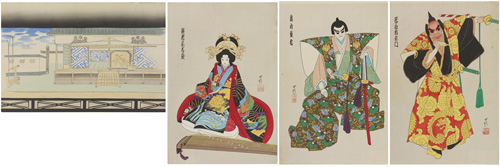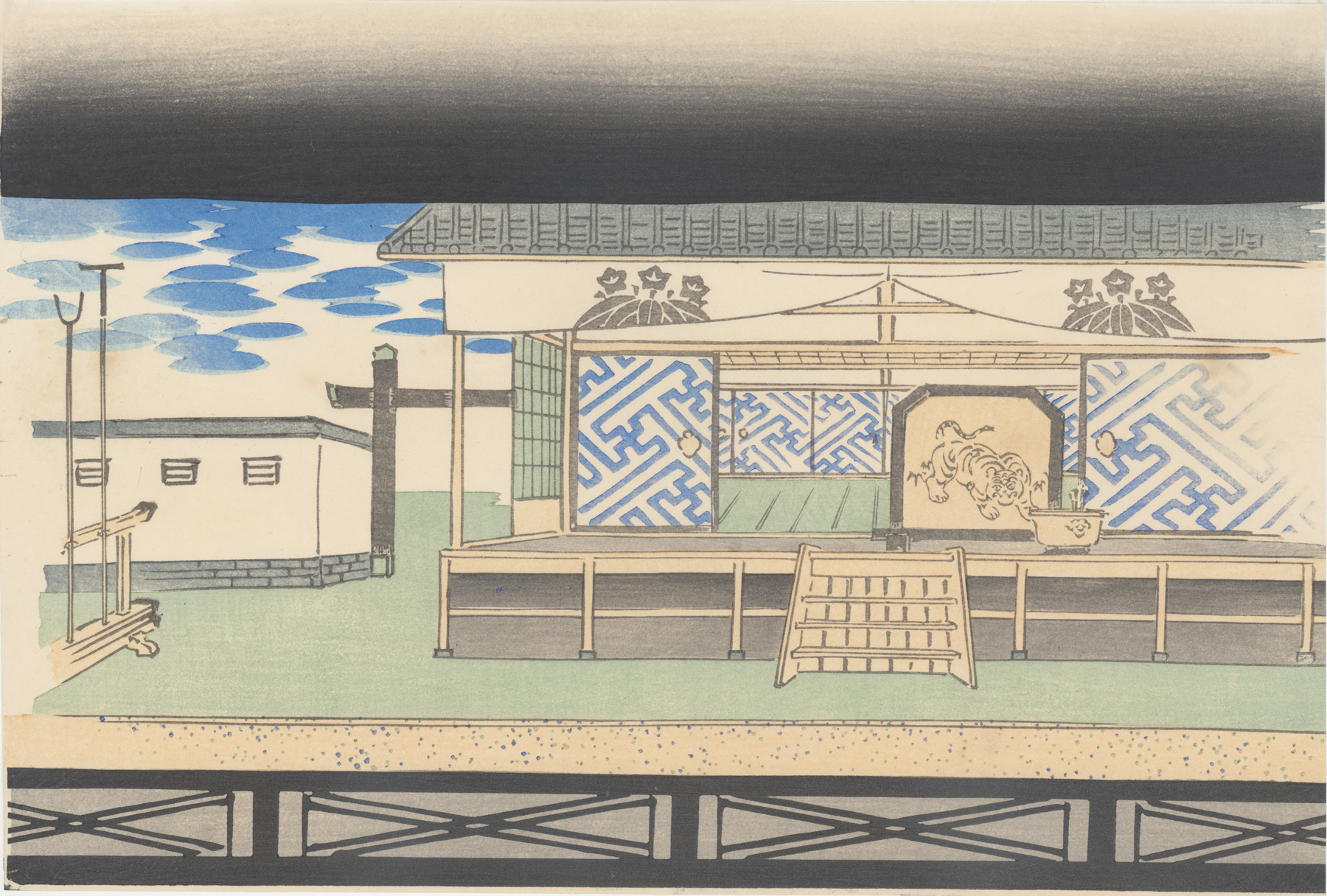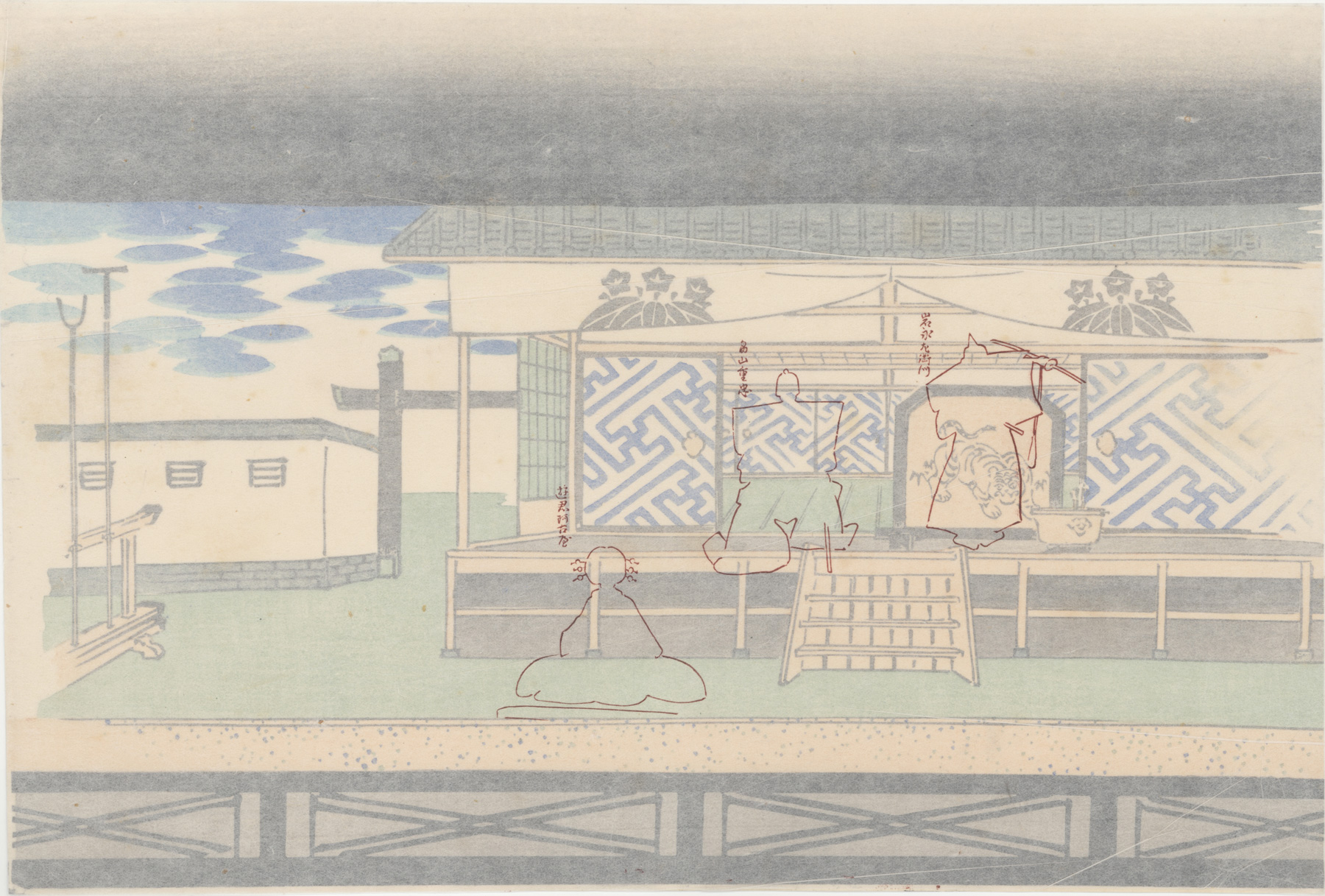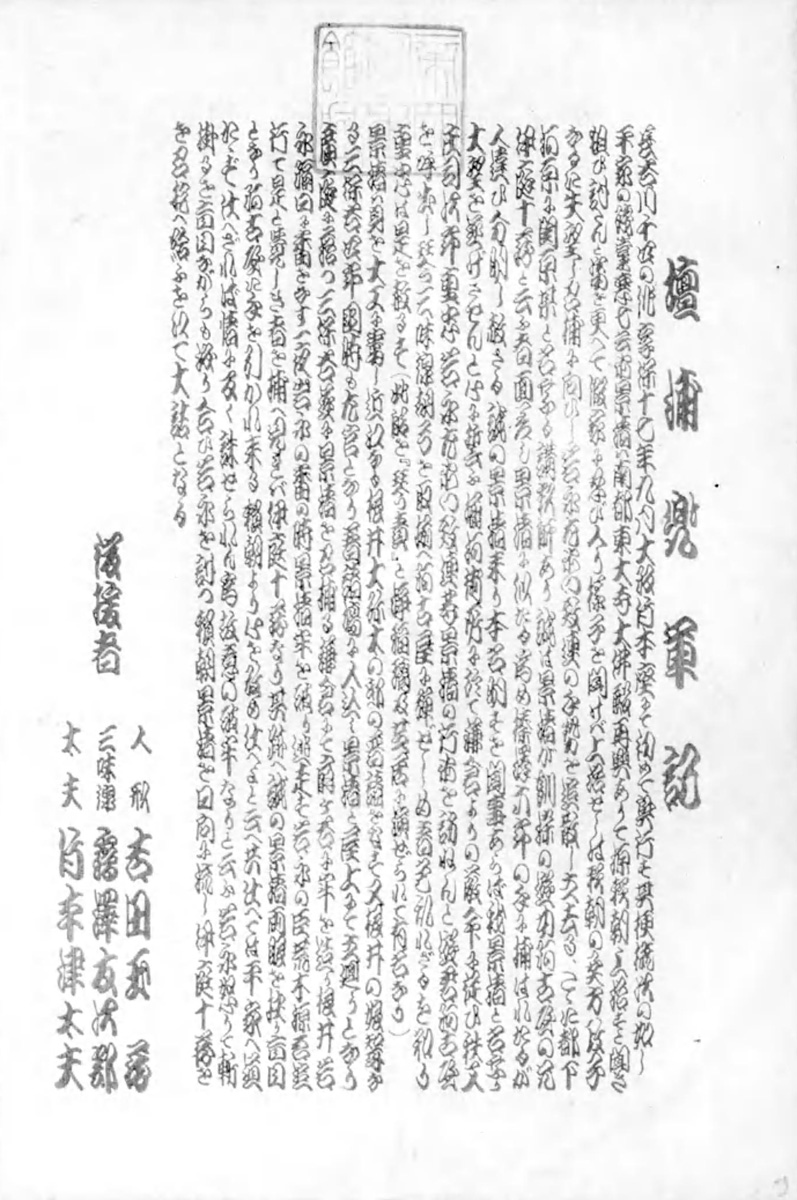About This Print
An illustration of the stage set for the play Dan-no-ura Kabuto Gunki [Chronicle of the Battle of Dan-no-ura] was written by Matsuda Bunkodo 文耕堂 (fl. 1713-1741;aka Matsuda Wakichi) and Hasegawa Senshi 長谷川千四 (1689-1733) and first performed in September 1732 in Osaka.As originally issued, this print is complete with its tissue overlay showing the outlines of three puppet characters as they appear on stage.
Akoya, an entertainer in the pleasure quarters of Kyoto, was mistress to an aristocrat, a Heike warrior named Taira Kagekiyo. In 1185 he was captured in the battle of Dan-no-ura, but was able to escape. Akoya was interrogated about his whereabouts by Iwanga Saemon Munetsura, an assistant of Hatakeyama Shigetada (samurai that fought in the Dan-no-ura battle) in a palace at Horikawa. He threatened Akoya with torture if she would not reveal where Taira was hiding. Shigetada had his own plan to discover if she told the truth and presented Akoya with three instruments, the koto, shamisen and kokyu and asked her to perform for him. She plays all three instruments with such perfection that Shigetada has no reason not to trust her and accepts that she does not know where Kagekiyo is. An irritated Iwanga releases her.

Brief Plot Summary
Bunraku Stage Set

Stage Set for Ehon Taikoki (Records of the Taiko)
image source: website of Japan Arts Council Invitation to Bunraku
Source: Bunraku: The Art of the Japanese Puppet Theatre, Donald Keene and Hiroshi Kaneko, Kodansha International, Ltd., 1965, p. 22.
For those unfamiliar with the stage set for bunraku the following passages from Donald Keene's Bunraku: The Art of the Japanese Puppet Theatre are instructive:
"Soon after the chanter enters his description of the new scene, the curtain is drawn aside to reveal the set, a naturalistic rendering of a landscape or interior. If the backdrop represents an outdoor scene, it is painted on a series of vertical panels which may be moved laterally to suggest that characters (who remain in one place) are traveling. If an interior, the gate, framework of the house, and generally one room are depicted, with the suggestion of other rooms beyond. A garden or nearby building may also be represented. A doorway at the rear-center of the stage is usual, for it permits the female characters to make spectacular exits, displaying their figures from behind. Very few props are used; unless necessary to the action, the furnishings are generally painted on the backdrop, to allow the operators the maximum freedom of movement.
The Bunraku stage, traditionally 36 feet wide, 25 feet deep, and 15 feet high, is divided into various playing areas. The main stage occupies about half the total area, and often serves as the interior of a house. Three raised partitions of different heights run across the width of the stage, standing before the trench-like passages in which the operators work. The partitions conceal the lower half of the principal operator's body, more of the operator of the left hand (who does not wear high-platformed clogs), and almost all of the operator of the feet; at the same time, they provide the apparent floor or ground level on which the puppets walk or sit. To the audience's right is a dais projecting into the auditorium from the stage. There the chanter perches on bulky cushions before an elaborately fashioned reading-stand; to his left, the samisen player sits on a single cushion, dwarfed by the chanter."
The Other Prints in the Dan-no-ura Kabuto Gunki Set
As further explained below, each stage set print was part of a set of five prints consisting of a black and white explanatory sheet and three portraits of puppet characters appearing in the play.
explanatory sheet
壇浦兜軍記 Dan-no-ura Kabuto Gunki
click on image to enlarge

The four print set for Dan-no-ura Kabuto Gunki puppets from left to right (as positioned on the stage set print's tissue overlay):Yūkun Akoya 遊君阿古屋, HatakeyamaShigetada 畠山重忠, Iwanaga Saemon 岩永左衛門
About the "Illustrated Collection of Famous Japanese Puppets of the Osaka Bunrakuza"
This collection of forty-eight color woodblock prints was designed by Hasegawa Sadanobu III (Konobu III) (1881-1963) and issued over the period March 1926 (Taishō 15) to August 1927 (Shōwa 2)1 by the publishing houses Bijutsusha 美術社 in Tokyo and on a subscription (members only) basis by Hangakai hanmoto 版画会板元 (板畫會板元) in Kyoto. The cost per print set was 3 yen. The editor and publisher for both the Bijutsusha and Hangakai hanmoto sets was Hayashi Eikichi 林榮吉, who was also the editor for Hasegawa's Collection of One Hundred Kumadori Makeups in Kabuki. (See Hasegawa Sadanobu III (Konobu III) (1881-1963) for prints from this collection.)
The Illustrated Collection of Famous Japanese Puppets of the Osaka Bunrakuza consists of twelve sets of prints each set depicting a specific play in the bunraku repertory, as listed in the below table. Each set contains a stage set for the specific play along with three prints of puppet characters appearing in the play and an explanatory sheet, for a total of forty-eight color woodblock prints and twelve monochrome explanatory sheets. Each of the stage set prints was originally issued with a tissue overlay showing the position of the three puppet characters on the stage. All of the plays pictured were performed at the Bunraku Theater (Bunraku-za) located within the Goryō Shrine compound in Osaka. The Goryō Bunraku-za burned down in November 1926 after what has been described as "an extremely difficult managerial era" and "lost interest" by the public in the late Taishō era.2 It is unknown what role, if any, the management of the Goryō Bunraku-za may have played in the formulation and issuance of this print series in their efforts to revitalize the theater.
For more complete information on this series see the article Illustrated Collection of Famous Japanese Puppets of the Osaka Bunrakuza
1 Dates are taken from the colophons on the envelopes containing the print sets in the Waseda University Archives2 National Diet Library website page http://www.ndl.go.jp/scenery/e/column/kansai/goryo_bunrakuza.html which provides a history of the Goryō Bunrakuza.
Play Name in Japanese Play Name in English 壇浦兜軍記
Dan-no-ura kabuto gunki Chronicle of the Battle of Dan-no-ura 義経千本桜
Yoshitsune senbon zakura Yoshitsune and the Thousand Cherry Trees 一の谷嫩軍記
Ichi-no-tani futaba gunki Chronicle of the Battle of Ichinotani 仮名手本忠臣蔵、五段目
Kanadehon Chūshingura, go danme The Treasury of Loyal Retainers, Act 5 仮名手本忠臣蔵、七段目
Kanadehon Chūshingura, shichi danme The Treasury of Loyal Retainers, Act 7 伊賀越道中双六
Igagoe dōchū sugoroku The Revenge at Igagoe 心中天網嶋
Shinjū ten no amajima The Love Suicides at Amijima 新版歌祭文
Shinpan Utazaimon The New Scandalous Ballad of Osome and Hisamatsu 菅原伝授手習鑑
Sugawara Denju Tenarai Kagami Sugawara and the Secrets of Calligraphy 本朝廿四孝
Honchō nijūshikō Twenty-four Examples of Filial Piety 鎌倉三代記
Kamakura sandaiki Three Generations of Kamakura Shoguns 夏祭浪花鑑
Natsumatsuri Naniwa kagami Summer festival at Naniwa (Osaka)
| Play Name in Japanese | Play Name in English |
| 壇浦兜軍記 Dan-no-ura kabuto gunki | Chronicle of the Battle of Dan-no-ura |
| 義経千本桜 Yoshitsune senbon zakura | Yoshitsune and the Thousand Cherry Trees |
| 一の谷嫩軍記 Ichi-no-tani futaba gunki | Chronicle of the Battle of Ichinotani |
| 仮名手本忠臣蔵、五段目 Kanadehon Chūshingura, go danme | The Treasury of Loyal Retainers, Act 5 |
| 仮名手本忠臣蔵、七段目 Kanadehon Chūshingura, shichi danme | The Treasury of Loyal Retainers, Act 7 |
| 伊賀越道中双六 Igagoe dōchū sugoroku | The Revenge at Igagoe |
| 心中天網嶋 Shinjū ten no amajima | The Love Suicides at Amijima |
| 新版歌祭文 Shinpan Utazaimon | The New Scandalous Ballad of Osome and Hisamatsu |
| 菅原伝授手習鑑 Sugawara Denju Tenarai Kagami | Sugawara and the Secrets of Calligraphy |
| 本朝廿四孝 Honchō nijūshikō | Twenty-four Examples of Filial Piety |
| 鎌倉三代記 Kamakura sandaiki | Three Generations of Kamakura Shoguns |
| 夏祭浪花鑑 Natsumatsuri Naniwa kagami | Summer festival at Naniwa (Osaka) |
Print Details
IHL Catalog
#2478 Title or Description Bunraku Theater Stage Set for Dan-no-ura Kabuto Gunki [Chronicle of the Battle of Dan-no-ura]
Bunraku ningyō butaizu Dan-no-ura Kabuto Gunki
文楽人形、舞台図、壇浦兜軍記
Note: Also translated as The Battle of Dan-no-ura; Chronicle of the Dan-no-ura Helmet Series Illustrated Collection of the Famous Japanese Puppets of the Osaka Bunrakuza
Ōsaka Bunraku-za Ningyō Gashū: Nihon Meibutsu
日本名物大阪文楽座人形画集 Artist Hasegawa Sadanobu III (Konobu III) (1881-1963)
Signature not signed Seal not sealed
Publication Date Taishō 15 or Shōwa 2 (1926 or 1927) Publisher 美術社 Bijutsusha, Tokyo and 版画会板元 Hangakai hanmoto, Kyoto Carver 佐藤重一 Satō Jūichi Printer 板垣八重松 Itagaki Yaematsu Impression excellent Colors excellent
Condition excellent
Genre puppet theater stage set picture 文楽人形、舞台図 bunraku ningyō, butaizu Miscellaneous Format
H x W Paper
9 7/8 x 14 3/4 in. (25.1 x 37.5 cm)
H x W Image 9 7/8 x 14 3/4 in. (25.1 x 37.5 cm) Literature
Collections This Print
Waseda University Cultural Resource Database 201-1497; Ritsumeikan University Art Research Center AcNo. arcBK06-002_05; National Diet Library Call Number 414.38; The Met Thomas J. Watson Library 240.3081 H27 Quarto; British Library System number: 018894603
last revision:5/14/2021 created
| IHL Catalog | #2478 |
| Title or Description | Bunraku Theater Stage Set for Dan-no-ura Kabuto Gunki [Chronicle of the Battle of Dan-no-ura] Bunraku ningyō butaizu Dan-no-ura Kabuto Gunki 文楽人形、舞台図、壇浦兜軍記 Note: Also translated as The Battle of Dan-no-ura; Chronicle of the Dan-no-ura Helmet |
| Series | Illustrated Collection of the Famous Japanese Puppets of the Osaka Bunrakuza Ōsaka Bunraku-za Ningyō Gashū: Nihon Meibutsu 日本名物大阪文楽座人形画集 |
| Artist | Hasegawa Sadanobu III (Konobu III) (1881-1963) |
| Signature | not signed |
| Seal | not sealed |
| Publication Date | Taishō 15 or Shōwa 2 (1926 or 1927) |
| Publisher | 美術社 Bijutsusha, Tokyo and 版画会板元 Hangakai hanmoto, Kyoto |
| Carver | 佐藤重一 Satō Jūichi |
| Printer | 板垣八重松 Itagaki Yaematsu |
| Impression | excellent |
| Colors | excellent |
| Condition | excellent |
| Genre | puppet theater stage set picture 文楽人形、舞台図 bunraku ningyō, butaizu |
| Miscellaneous | |
| Format | |
| H x W Paper | 9 7/8 x 14 3/4 in. (25.1 x 37.5 cm) |
| H x W Image | 9 7/8 x 14 3/4 in. (25.1 x 37.5 cm) |
| Literature | |
| Collections This Print | Waseda University Cultural Resource Database 201-1497; Ritsumeikan University Art Research Center AcNo. arcBK06-002_05; National Diet Library Call Number 414.38; The Met Thomas J. Watson Library 240.3081 H27 Quarto; British Library System number: 018894603 |
5/14/2021 created




